Dialogue Meetings
The Institute of Environmental Radioactivity (IER) of Fukushima University is the only academic research institute that conducts leading-edge research in the field of environmental radioactivity, and also plays a role as a research institute located in Fukushima Prefecture, which has a problem of radioactive contamination. In particular, we conduct research with the understanding and cooperation of local government officials and local residents in areas such as the Fukushima Prefecture Evacuation Area. IER holds a Research Activities roundtable to provide feedback on its Research Output activities to local residents and to listen to their frank opinions.
December 10, 2022 The 18th Dialog meeting was held at in Iwaki, FukushimaNew!
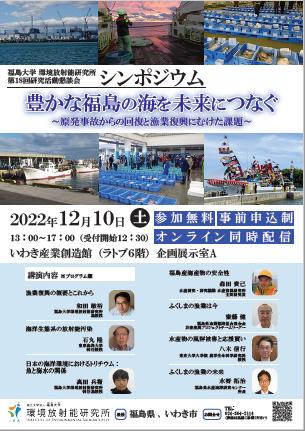 Flyer
Flyer
| Date & time: | Saturday, December 10, 2022, 13:00-17:00 |
| Venue: | Iwaki Business Innovation Center, Planning Exhibition Hall A |
Since 2016, we have been conducting the dialog meetings to feedback our research results to local communities. On December 10, 2022, the 18th dialog meeting entitled Symposium: "Linking the Productive Sea of Fukushima to the Future -Issues for Recovery from the Nuclear Power Plant Accident and Reconstruction of the Fishery Industry-" was held. Approximately 140 people attended the symposium both online and at the venue.
This symposium was planned amidst growing concerns about new reputation damage about the marine environment in Fukushima Prefecture due to the decision to discharge ALPS treated water from the Fukushima Daiichi Nuclear Power Plant into the ocean, even as the concentration of radioactive materials in marine products has declined markedly and the fisheries cooperatives in Fukushima aims to systematically increase the amount of fish caught.
Speakers included researchers affiliated with IER, researchers who have been investigating the marine environment and radioactive contamination of marine products after the accident from the perspectives of natural science and social science, and researchers who have been working on the reconstruction of Fukushima Prefecture's fishery industry from the perspective of fisheries cooperative association and prefectural government agencies. They presented the research result revealed so far and the efforts for future.
At the end of the discussion session, each presenters spoke about their thoughts on fishery recovery, and participants commented that "the explanation of the current situation of fishery, fish, and ocean, explained by scientific data, deepened my understanding" and "I could understand the current situation of fishery in Fukushima.”, “I think it is important to consider a renewed idea for the coastal environmental utilization of Fukushima prefecture rather than restoring to the original state before the disaster “. and “It is desirable to exchange information with the younger generation who will lead the next generation.”
IER will continue to provide opportunities to exchange opinions with the public, including the residents of Fukushima Prefecture, so that the results of our research can be linked to the reconstruction of Fukushima.
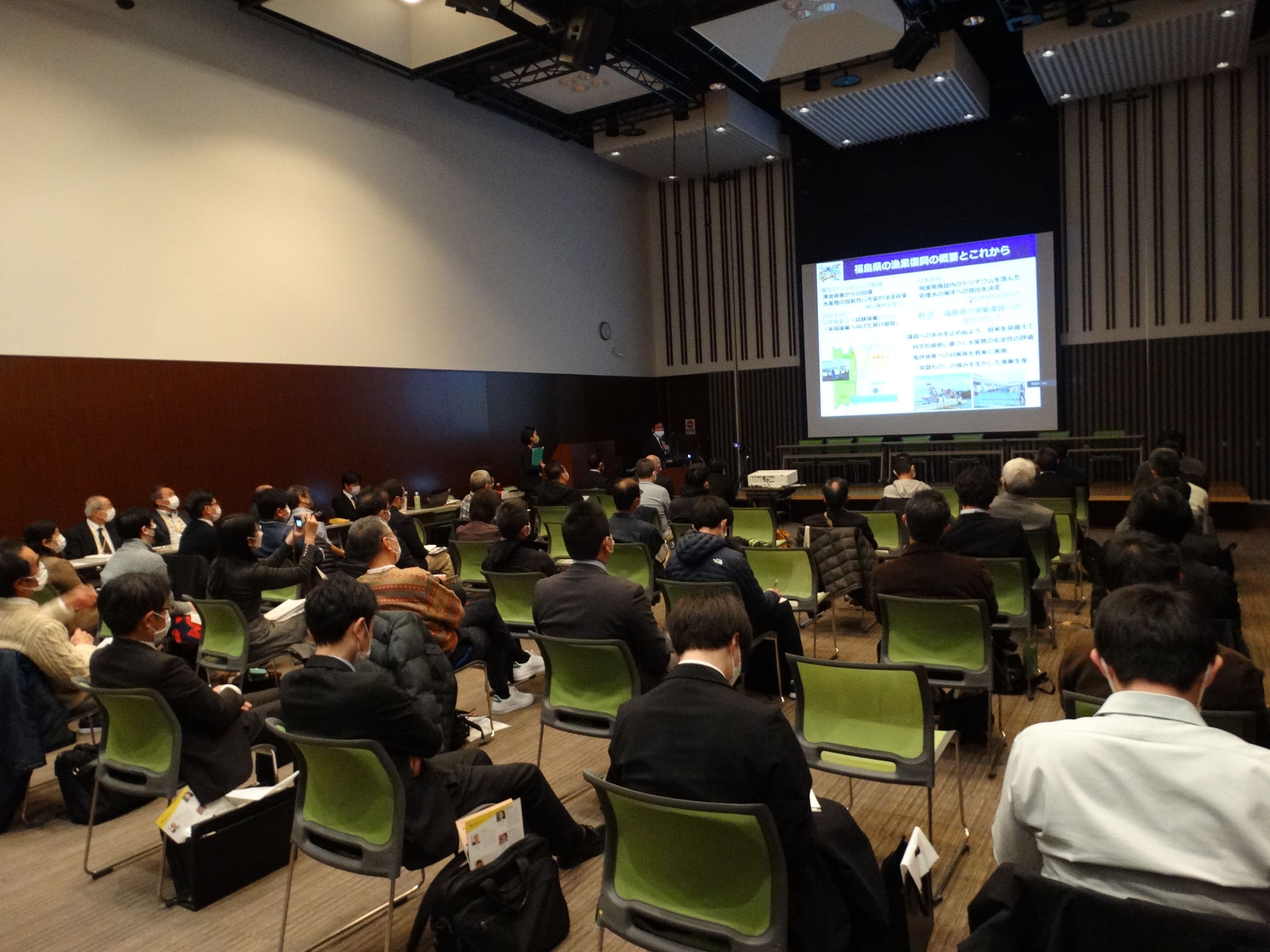 Participants gathered from inside
Participants gathered from inside
and outside Fukushima Prefecture.
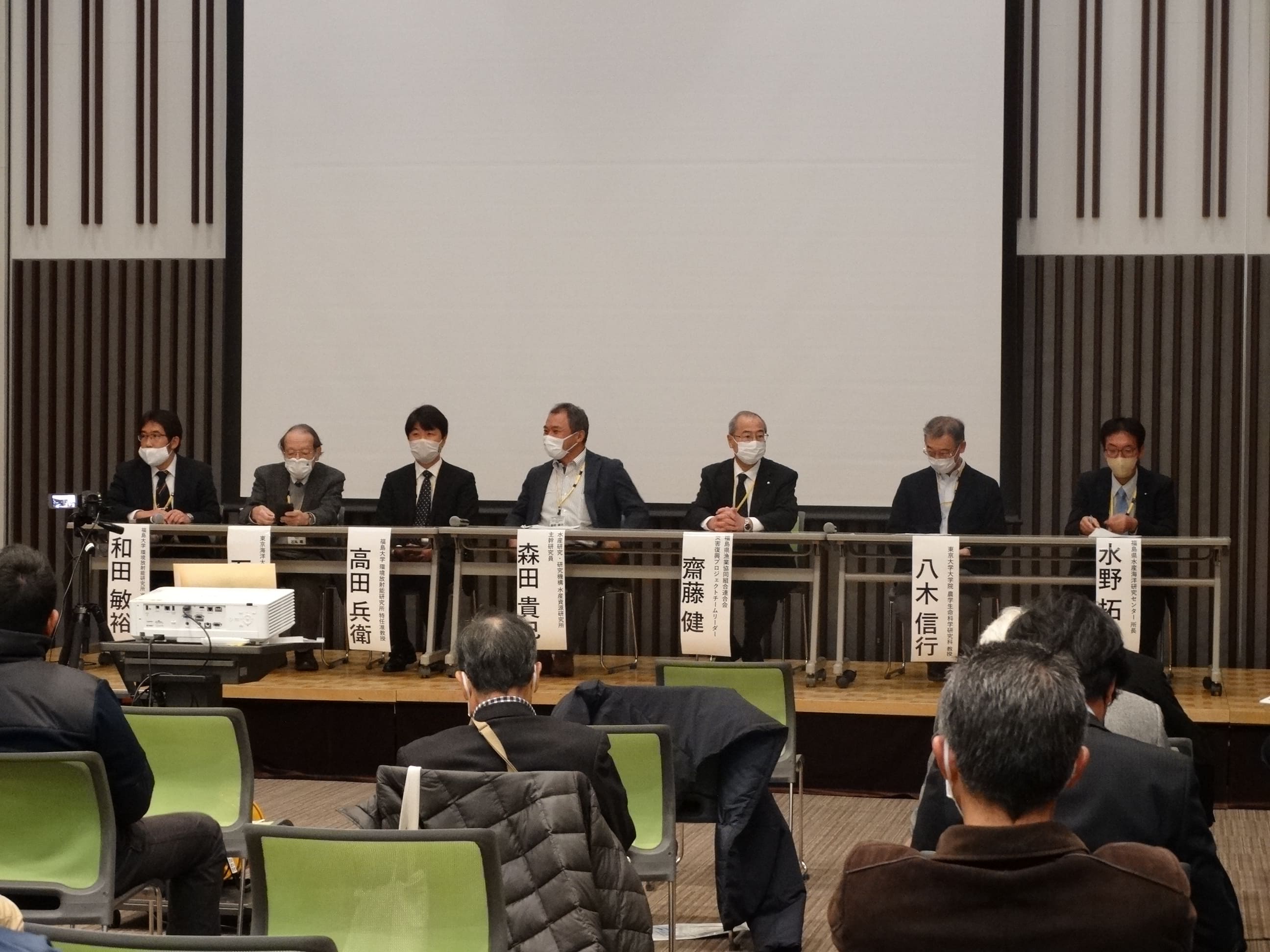 Discussion session
Discussion session
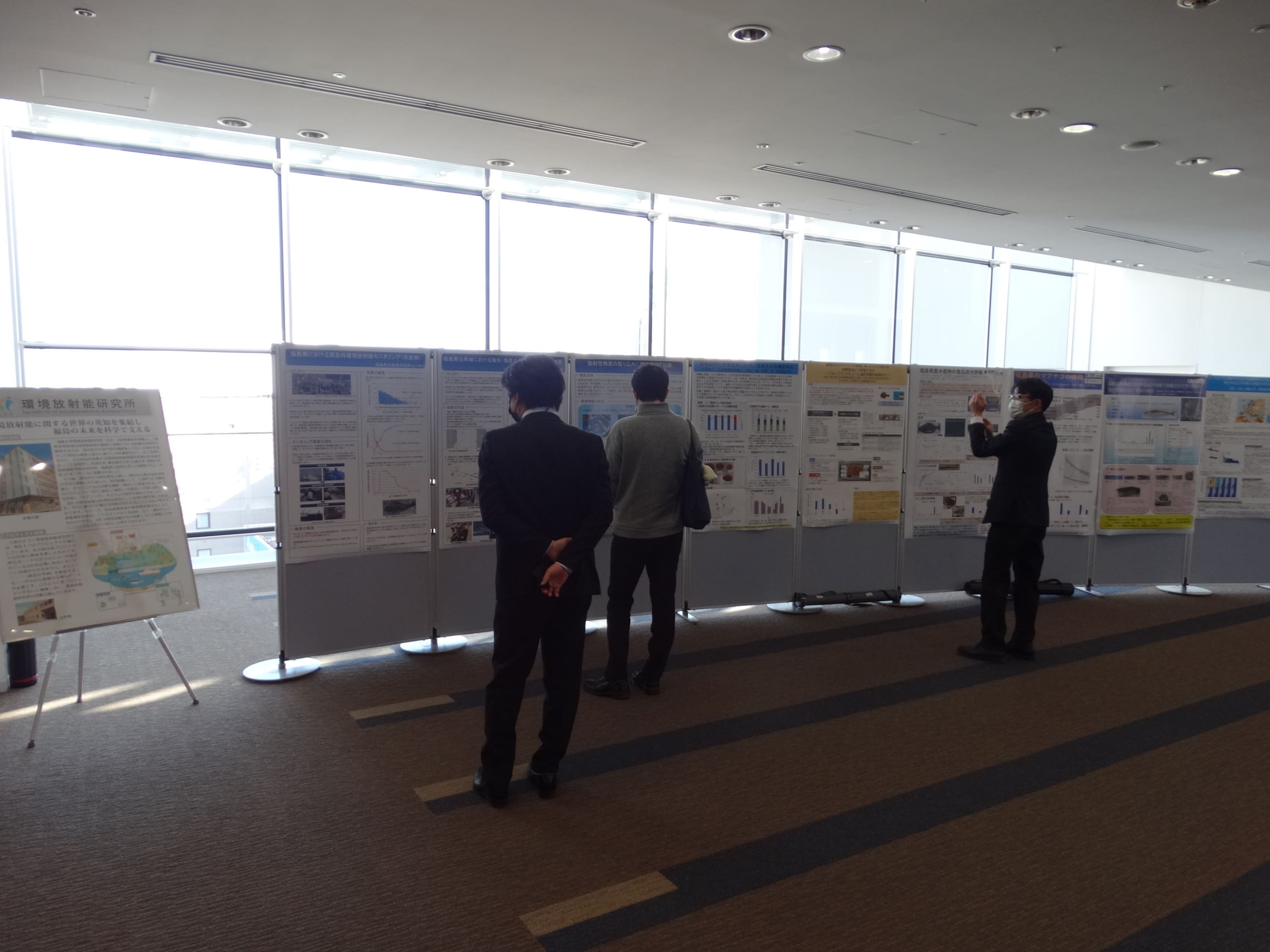 Posters of the research
Posters of the research
by the affiliated institutes
were displayed outside the venue.
February 13, 2022 17th Dialog meeting was held at Hiraishi community hall in Fukushima City
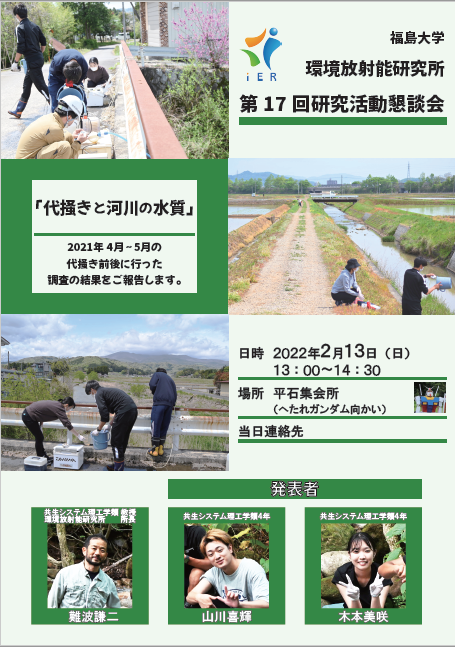 Flyer
Flyer
| Date: | Sunday, February 13, 2022, 1:00pm-2:30pm |
| Venue: | Hiraishi community hall in Fukushima City |
| Topics: | ●Presence of suspended 137Cs in the Abukuma River
(YAMAKAWA Yoshiki: Senior student, Faculty of Symbiotic Systems Science, Fukushima University)
●Seasonal variation of 137Cs in river water originating from forest and agricultural land
(KIMOTO Misaki: Senior student, Faculty of Symbiotic Systems Science, Fukushima University)
●Question session
(NANBA Kenji/ Director of IER, and Professor, Faculty of Symbiotic Systems Science, Fukushima University)
|
Since 2016, we have been organizing dialog meetings to feedback our research results to local communities. In the 17th dialog meeting, two senior students of the Faculty of Symbiotic Systems Science Fukushima University, YAMAKAWA Yoshiki and KIMOTO Misaki, who are preparing batchelrs’ thesis under the supervision of Prof. Nanba, presented their research under the theme of “Evaluation of radiocesium runoff into rivers due to “Shirokaki” (a preparation process of paddy fields before planting rice seedling) in Fukushima Prefecture” YAMAKAWA's theme of graduation thesis is “Morphology of suspended 137Cs in the Abukuma River” and KIMOTO has been working on the theme of” Seasonal variation of 137Cs in river water originating from forest and agricultural land” with the cooperation of professors at the IER (Dr. Igarashi, project assistant professor, and others). In this meeting, they reported on some of their research results and exchanged opinions with 10 participants from Hiraishi district of Fukushima City who helped them with their research in 2021 and 4 participants from Shimotoriwata district of Fukushima City who helped them in 2020. They have succeeded the research theme from MORITAKA Shota, who gave a presentation at the 14th dialogue meeting held in the Shimotoriwata in 2020.
Based on the observations conducted regularly at Kuroiwa, Fukushima City since 2012, YAMAKAWA explained that the concentration of dissolved radiocesium shows seasonal fluctuations with high levels in summer and low levels in winter, while there has been a long-term decreasing trend. He also explained that there is a particularly sharp increase in May every year. Since this rise in May suggests the possibility that radiocesium may be washed off into the river caused by Shirokaki activity, in 2020, he studied on muddy water appears in the paddies during Shirokaki in Shimotoriwata area, and in 2021, on how the water quality of the related waterways to the paddies changes before and after Shirokaki in the Hiraishi area. He shared the results indicating that the turbidity and 137Cs concentrations in the rice paddies during the Shirokaki were diluted to about 30 times before flowing into the waterways.
KIMOTO reported on a study she conducted that aimed to understand the impact of forests in addition to the impact of Shirokaki. The 137Cs concentration and water quality were compared between the observation points upstream of the Sugita River, where there are only forests, and downstream, where there are rice paddies. Upstream, approximately 80 % or more of the 137Cs in the river water was in dissolved form, while the ratio of suspended form increased downstream. However, the concentrations of dissolved 137Cs in the downstream were higher than those in the upstream in all seasons, and in particular, the concentrations of dissolved 137Cs in the downstream were 5 to 10 times higher than upstream concentrations on the days when Shirokaki was conducted. The results of the study indicated that although there is 137Cs runoff from forests, its contribution to the downstream was small, and that runoff from paddy fields during Shirokaki is considered to be a major contributor to the suspended and dissolved 137Cs concentrations in the downstream river water.
After the presentations, Director NANBA joined in the Q&A session. Participants asked questions such as, "Is the concentration of radioactive cesium in the river at a level that cannot be considered safe?” "I thought that radiocesium should be firmly adsorbed in the soil.” “How much radiocesium in the rice paddies is washed off?" and "What is the situation of radiocesium in the reservoirs upstream?” In response to the questions, "Even the highest concentration of dissolved 137Cs observed is 0.02 Bq/L, which is not a concentration that poses a safety problem," and "The movement of substances such as potassium around the paddy fields, which is visible due to the presence of radiocesium, may give us a hint.” The valuable questions and comments we received will be used in our future research at the IER.
(Note) Since 2012, Fukushima Prefecture has implemented measures to prevent radiocesium absorption by rice plants by applying zeolite and potassium fertilizer before planting seedlings, and all brown rice harvested in the prefecture was inspected in bags. Since there were no cases exceeding the standard for five years since 2015, only the samples of harvested brown rice have been inspected from 2020.
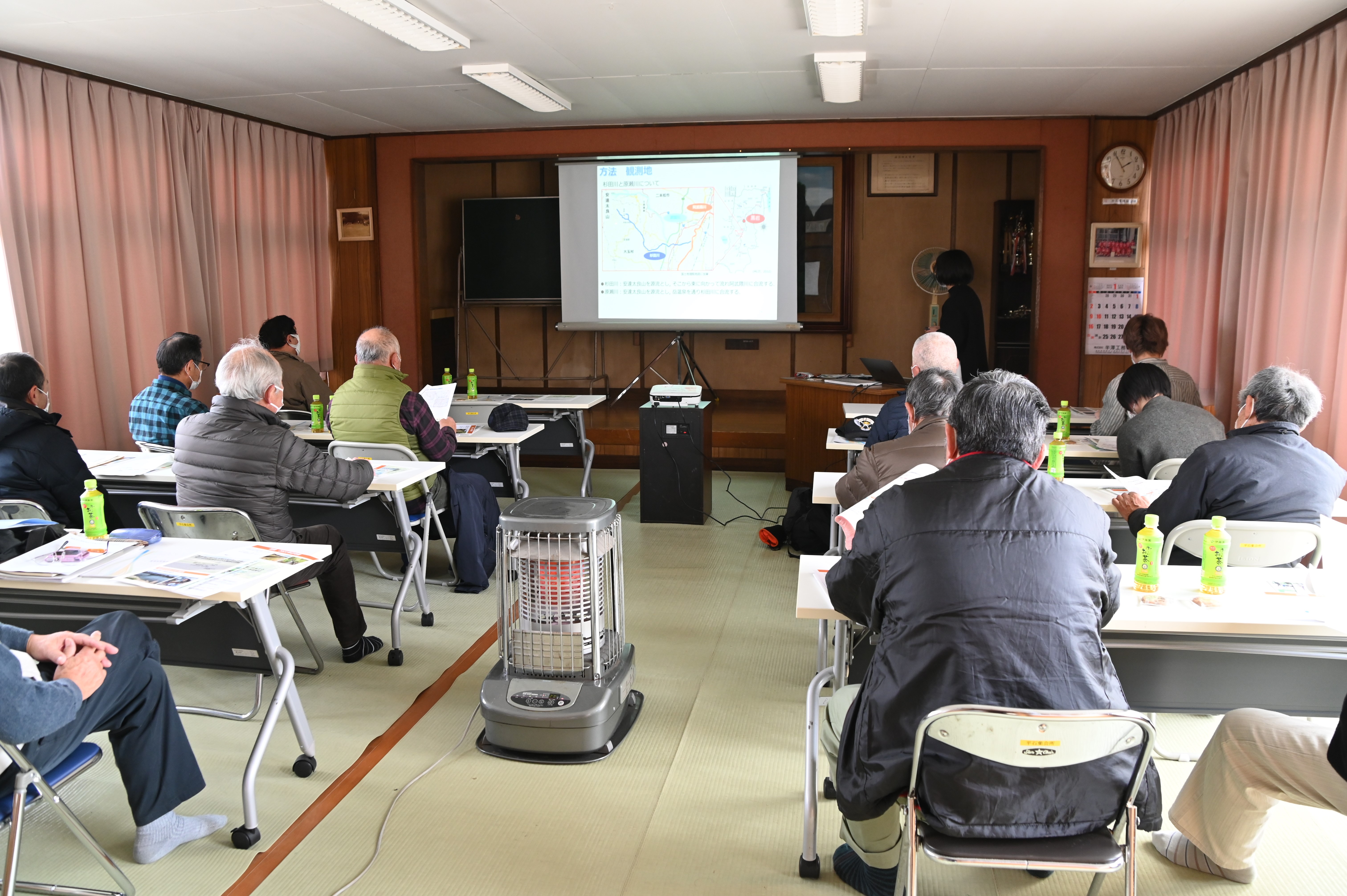 Presentation in the dialogue meeting
Presentation in the dialogue meeting
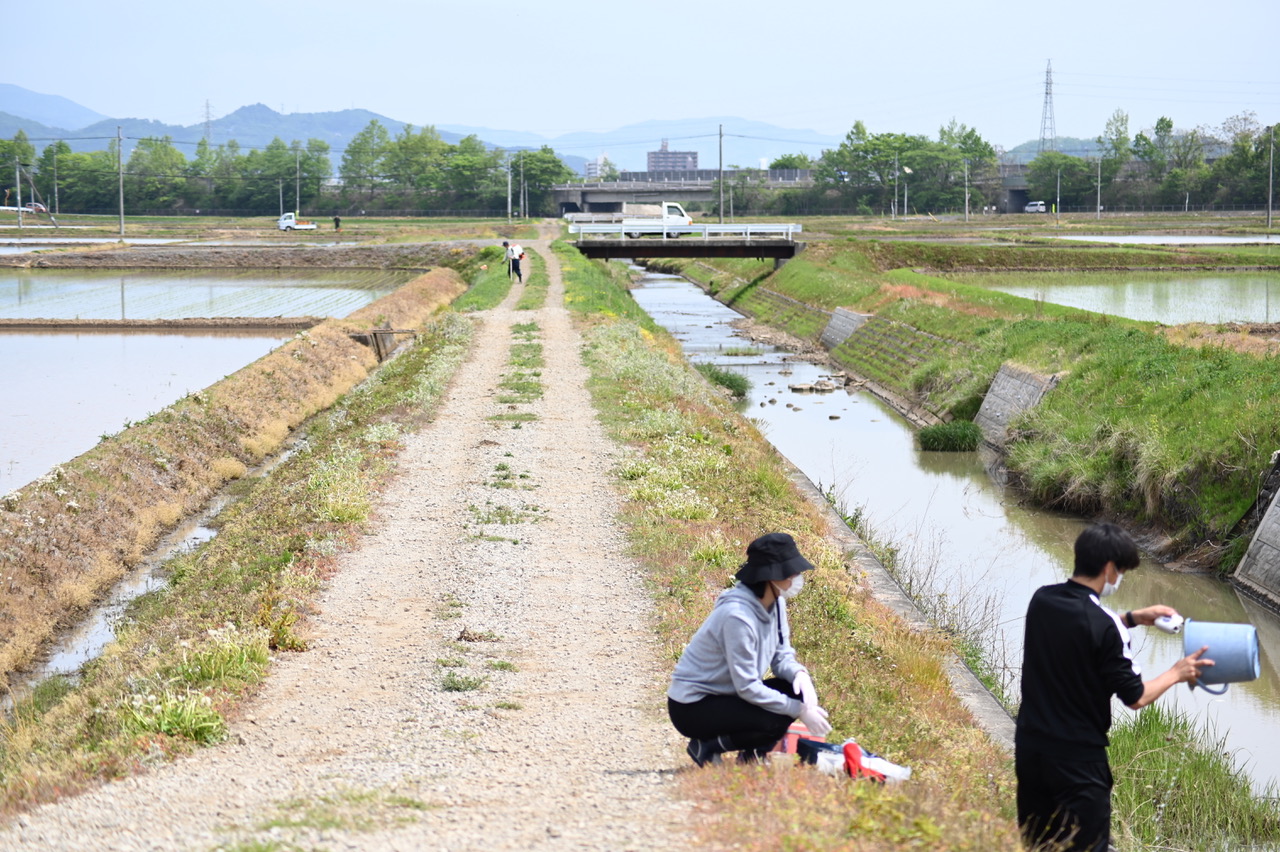 Field work
Field work
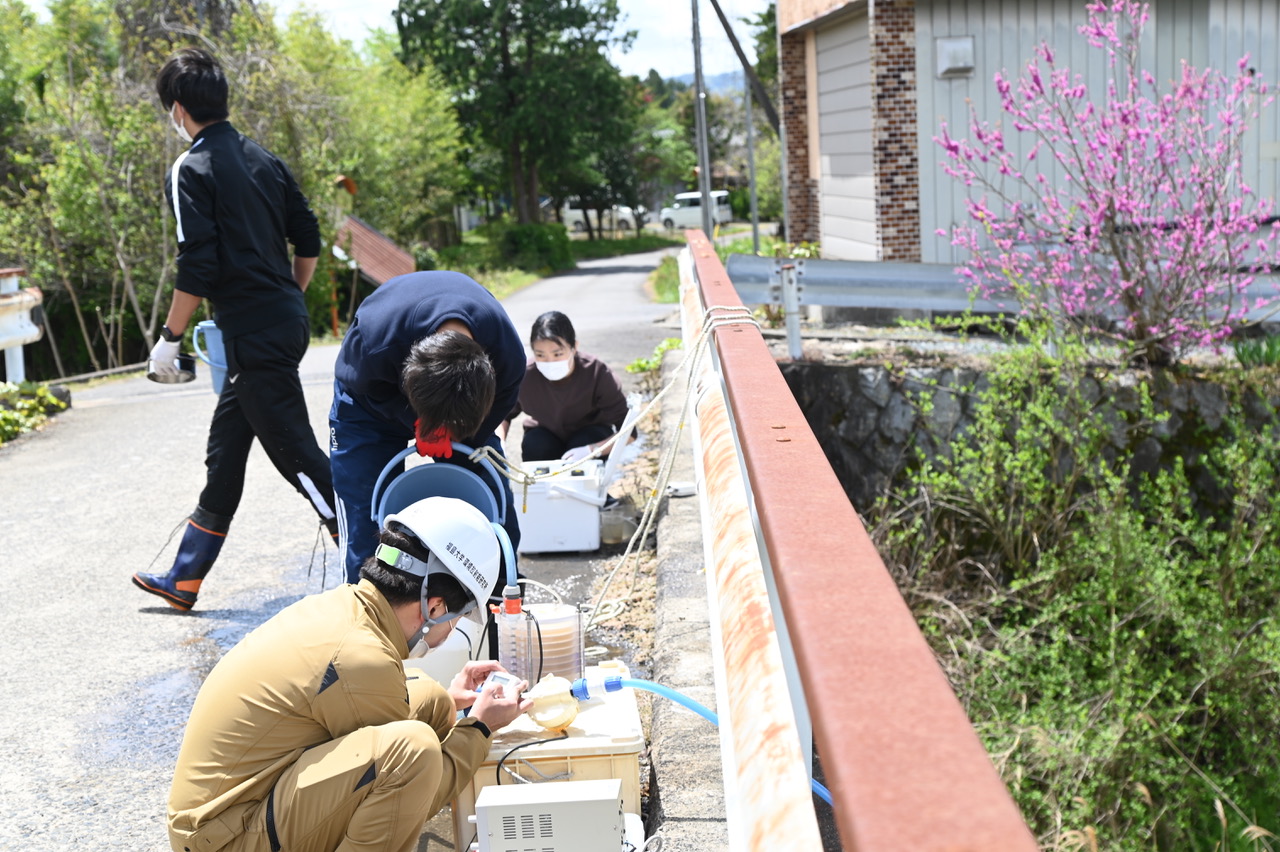 Field work
Field work
December 11, 2021 16th Dialogue meeting was held at Koriyama City.
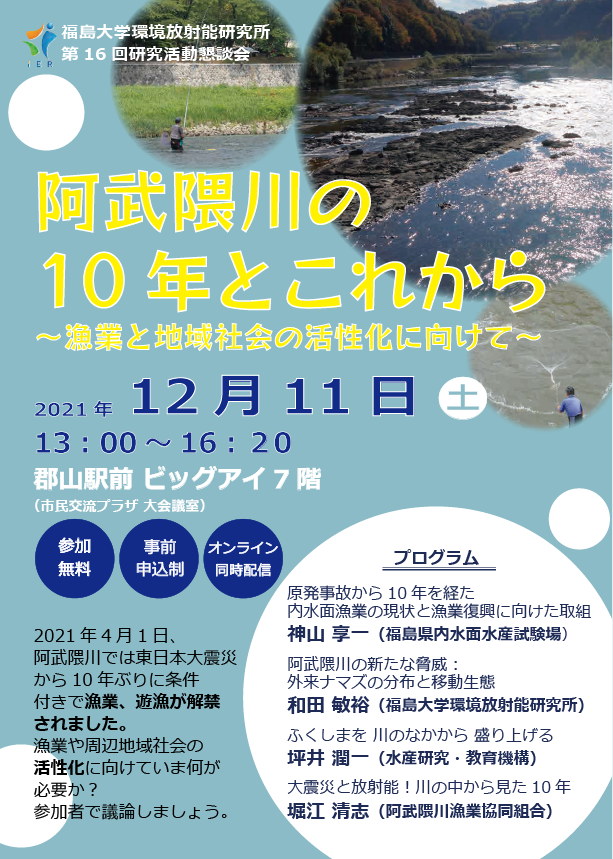 Flyer
Flyer
| Date: | December 11, 2021, Sat.1:00 pm to 4:30 pm |
| Venue: | Big-I 7th floor,and Zoom |
| Topcs: | Current status of inland water fisheries ten years after the Fukushima accident and efforts toward the recovery of fisheries activities.
(KAMIYAMA Junichi: Research manager of Fukushima Prefectural Inland Water Fisheries Exp. Stn.)
New threat of Abukuma River: distribution and migration ecology of introduced catfish
(WADA Toshihiro: Associate Professor, IER)
Introduction a project of “Koi ni Koisuru Koriyama” (Koriyama in love with Carp)
(NANBA Kenji: Directior/Professor, IER)
Boosting Fukushima from the River
(TSUBOI Junichi: Senior Researcher, National Research Institute of Fisheries Science, National Institute of Fisheries Research and Education)
The Great East Japan Earthquake and Radioactivity: A decade from the river
(HORIE Kiyoshi: Secretary General, Abukuma River Fishery Cooperative)
*Program order
|
Since 2016, we have been organizing dialogue meetings to feedback our reserch results to local communities. The 16th Dialogue meeting was held with five speakers under the theme of ”The last 10 years and the future of the Abukuma River:-Towards the revitalization of fisheries and local communities-”. The speakers gave presentations on current status, challenges, and future prospects of the Abukuma River, where some fishing activities (e.g., Ayu fishing) have resumed for the first time in 10 years after the Great East Japan Earthquake. This event was simultaneously broadcasted online, and a total of about 60 people participated in both online and at the venue.
Manager KAMIYAMA explained that the radiocesium contamination levels in freshwater fish in the Abukuma River system have been decreasing over the years, but the rate of decrease is slowing down, and that freshwater fish are more likely to store radiocesium than marine fish, resulting in relatively high levels in some cases. He also introduced the efforts to raise “Fishable Ayu” to revitalize the rivers in Fukushima.
Associate Professor WADA gave a presentation on a new threat in Abukuma River: non-native channel catfish. Channel catfish were imported from the U.S. for acuqculture purpose, but the recent study has revealed the drastic changes in fish species composition due to their proliferation in dam areas of Abukuma River. He also introduced the recent study using biotelemetry method that revealed the migration ecology and spawning sites of the catfish in the Shinobu Dam area, and pointed out the future issues such as comfirming spawning sites outside the dam area.
Director NANBA introduced Koriyama City’s project to promote carp cuisine, “Koi ni Koisuru Koriyama (Koriyama in love with carp)”, and a song of the project “Dokkoi song ~Sosui de Sweet na Koi no Uta~ (Sweet Carp Song of Love on the Canal)” that is being released on Koriyama City’s YouTube Channel.
Researcher TSUBOI presented the results of his research conducted in several rivers in Fukushima Prefecture on how Ayu (plecoglossus) take radiosesium, and explained that Ayu eat algae (food) attached to stones, which helps to clean the river. He also presented the coutermeasures against great cormorant, a natural enemy of ayu. He finally introduced his own efforts to promote leisure activities on rivers through books, websites, and YouTube channel.
Secretary HORIE explained the impact of the nuclear power plant accident using a map of Fukushima on the linig of his suit (photo ②). He compared the situation of the Abukuma River Fishery Cooperative 40 years ago and now, and said that although the situation is severe (drastic decrease in number of members, especially after the accdent), the number of members has increased due to the effectiveness of the recent campaign, and that in the future, he would like to revitalize the fishery cooperative by involving children and youger generation in their 30s and 40s.
After each presentation and during the time for exchanging opinions, various opinions and questions were raised, such as “how to create opportunities for children to come into contact with the river,” with concerns about young people leaving the rever, and a lively discussion took place.
The article was posted on News Topics of Fukushima University Website !
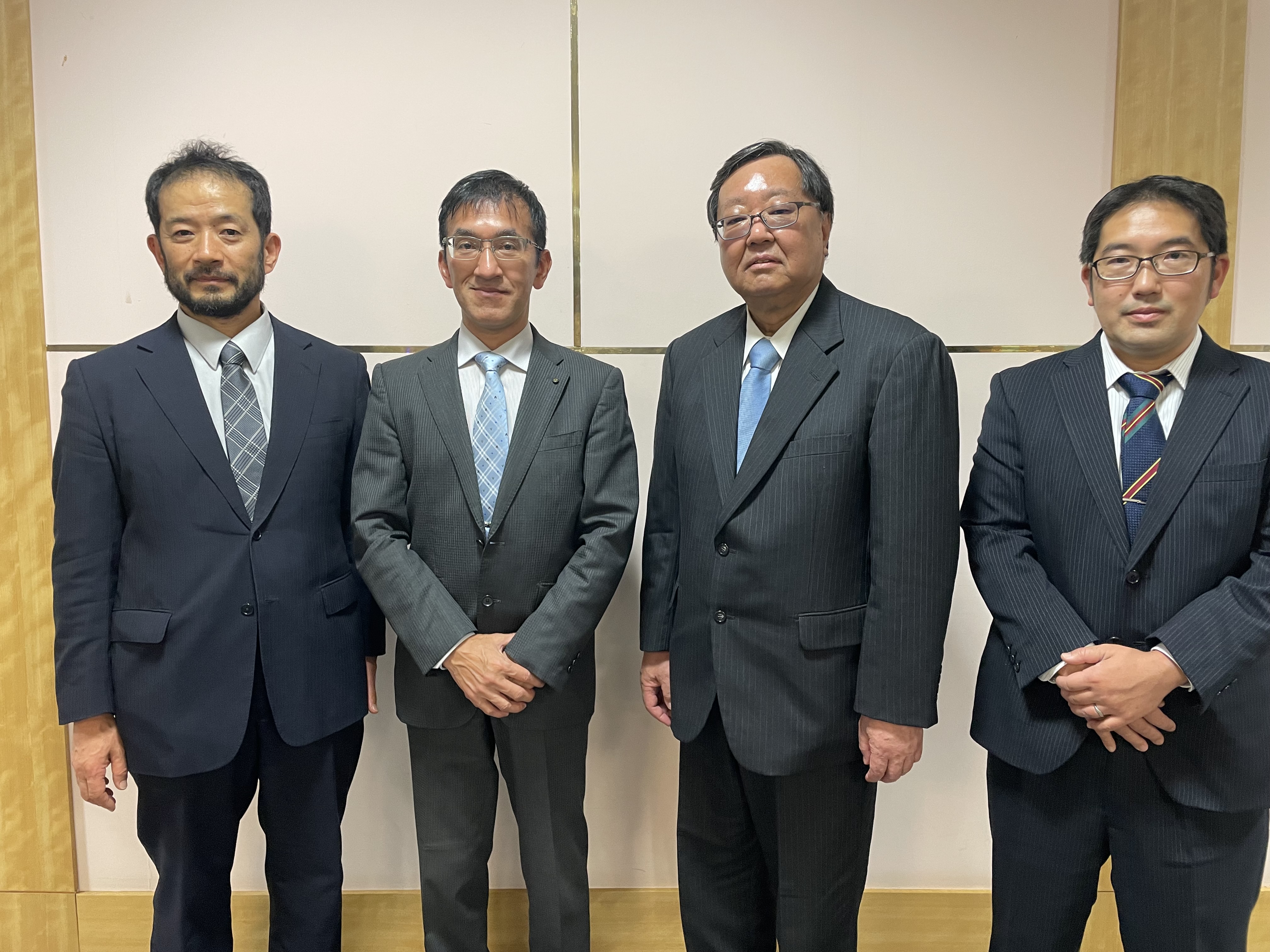 ①From left, Director NANBA, manager KAMIYAMA,
①From left, Director NANBA, manager KAMIYAMA,
Secretary HORIE, Associate Professor WADA
(Mr. TSUBOI is not in this photo)
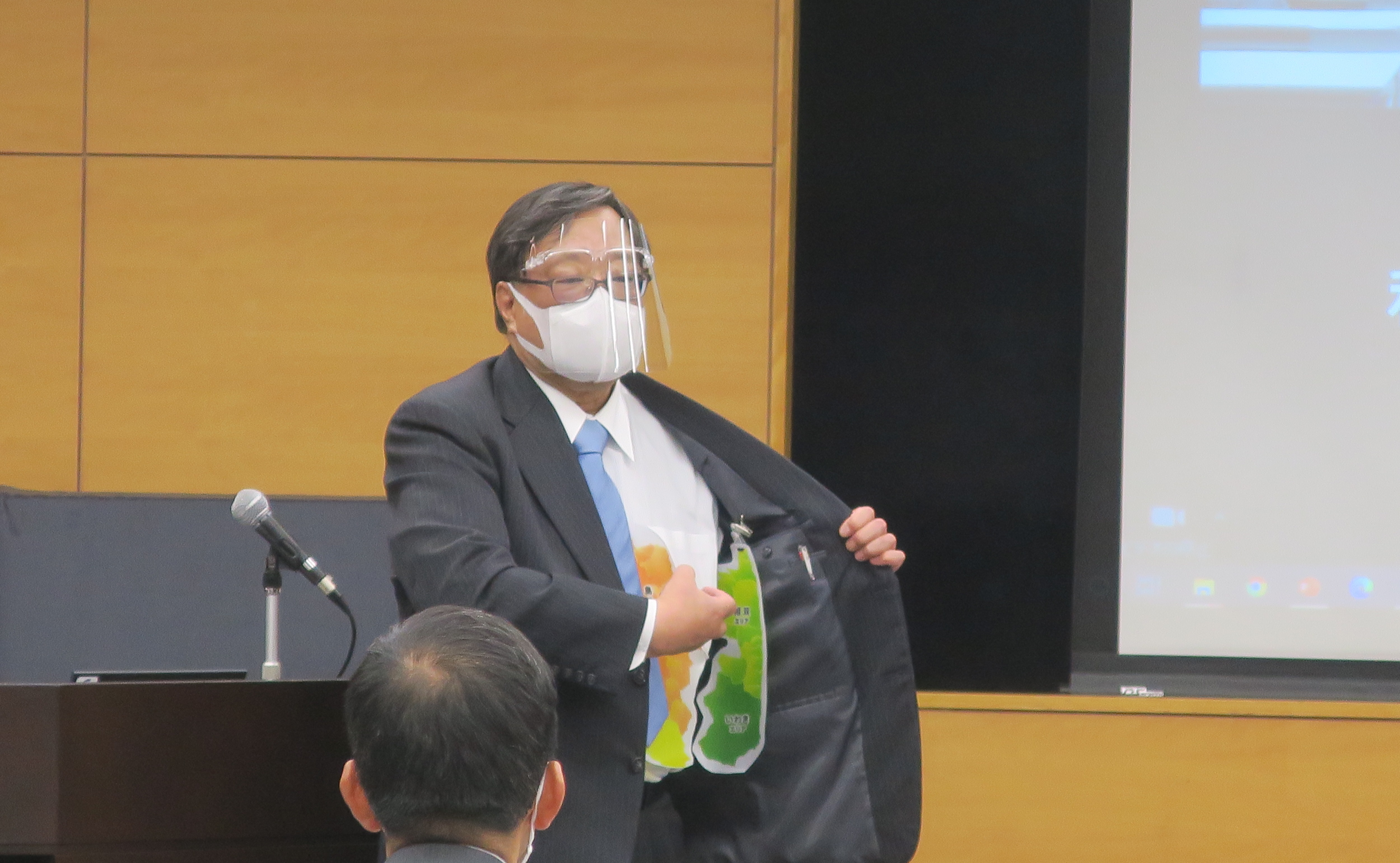 ②HORIE Secretary General,
②HORIE Secretary General,
Abukuma River Fishery Cooperative,
scene of the presentation
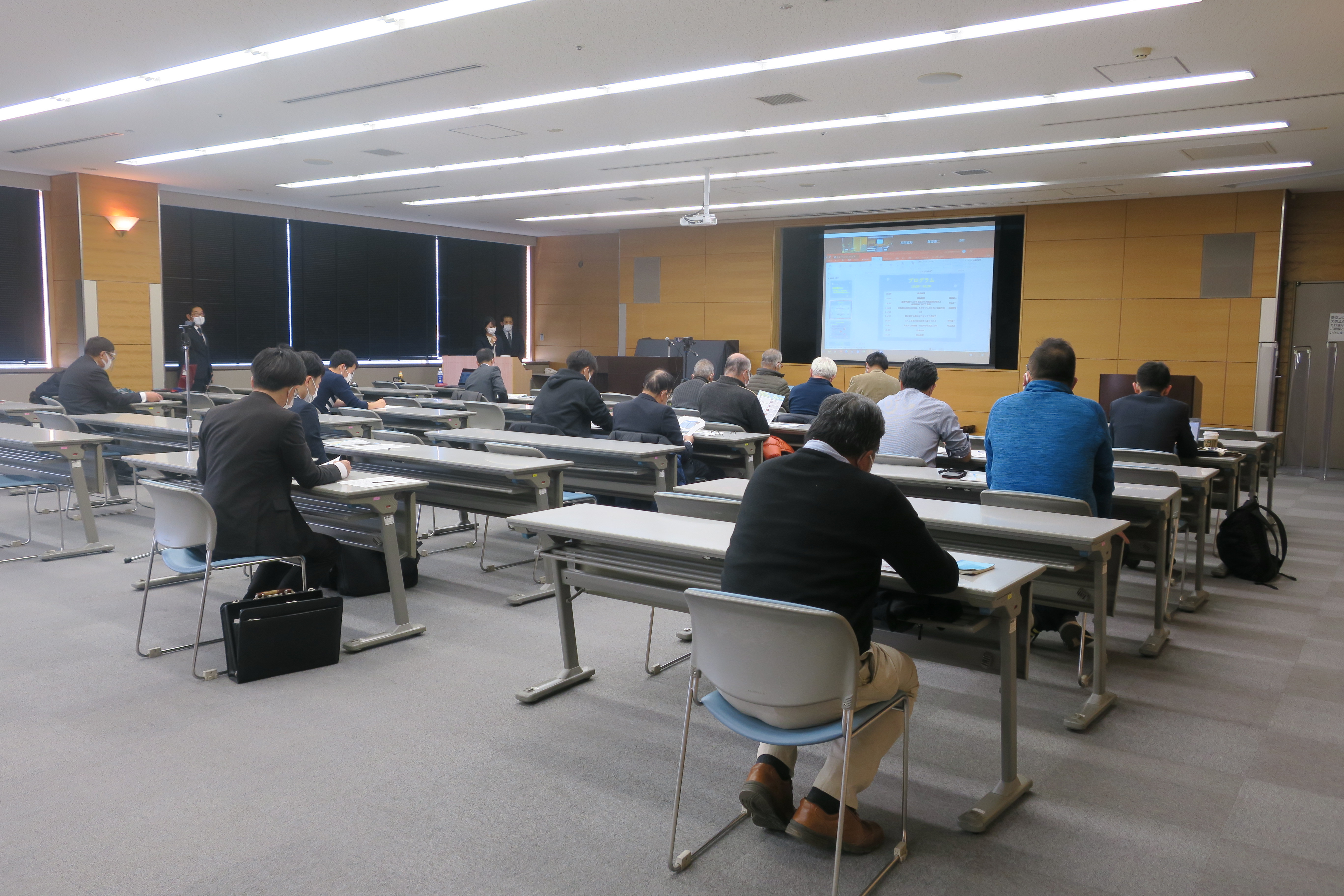 ③Overall view
③Overall view
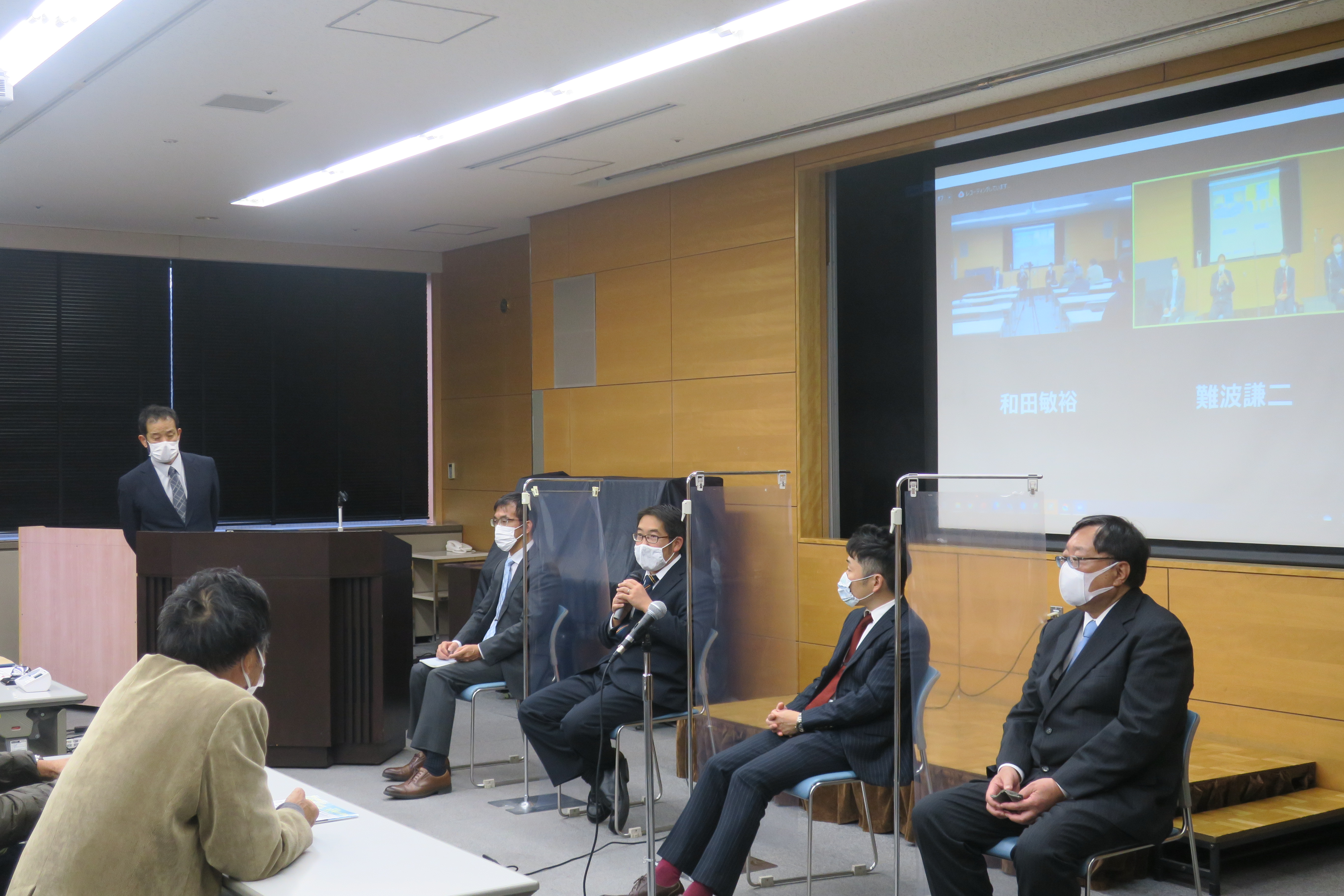 ④Participants and speakers having s discussion.
④Participants and speakers having s discussion.
November 27, 2020 15th Dialogue meeting was held at Naraha Junior High School
| Date : | Friday, November 27, 2020 13:25-15:15 |
| Venue : | Naraha Junior High School, Naraha Town, Fukushima Prefecture |
| Speaker : | Hirofumi Tsukada, Professor |
| Title : | Environmental Radioactivity after the nuclear accident in 2011. |
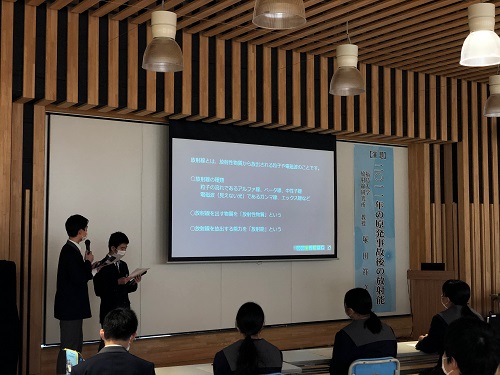 A presentation by representative students
A presentation by representative students
We held the second dialogue meeting in this fiscal year on November 27.
Professor Hirofumi Tsukada, who studies radionuclides contamination on crops, visited Naraha Junior High School and gave a lecture to approximately 40 students (from 1st to 3rd grade) and their teachers as part of radiation education. Mihoko Kikuchi, a master’s student of IER who is supervised by Prof. Tsukada, also contributed to organizing this event.
Most of the area of Naraha town is within 20 km of Fukushima Daiichi Nuclear Power Plant, and most of residents were forced to evacuate outside the town after the nuclear accident in 2011. Then, the evacuation order was lifted in September 2015, and Naraha Junior High School resumed educational activities in the town in April 2017.
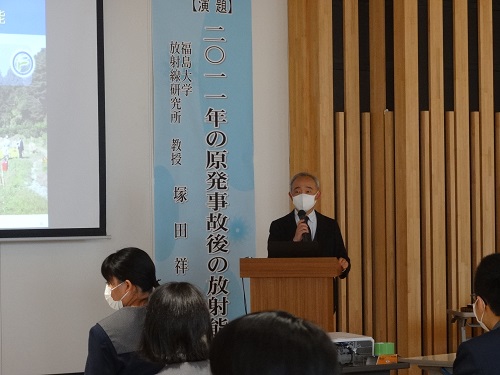 Prof. Tsukada giving a lecture
Prof. Tsukada giving a lecture
Prior to the lecture by Prof. Tsukada, several students who voluntarily joined the activity to measure dose rate in the town expressed how they felt after the activity. In particular, two students in third grade made a wonderful presentation on behalf of other students using slides about their measurement results and what they learned about radiation. Students told their impression like “I was relieved to know that even there are spots with high and low dose rates in the town, the dose rate is low enough where I usually live”, “we learned that decontamination made it possible for us to live in the town again”. Thus, they seemed to have removed their anxiety to radiation by joining the activity.
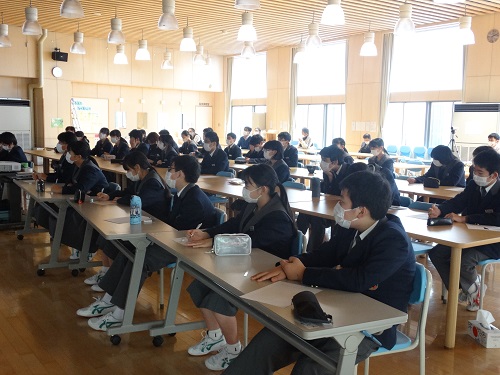 Students listening to the lecture seriously
Students listening to the lecture seriously
Prof. Tsukada started the lecture with the basics of radiation such as its history and talked about the mechanism of radionuclides transfer from soil of farmland to crops, with showing many figures. Although part of the lecture may have been difficult for junior high school students to understand, they were listening to it very seriously. A teacher told us later day that most of the students said that they learned more about radiation than before by listening to the lecture. During the break and after the lecture, we prepared a cloud chamber to show normally invisible radiation flying so that students can have an image of radiations. Some of the students who were looking at the cloud chamber said that they wanted to make it themselves.
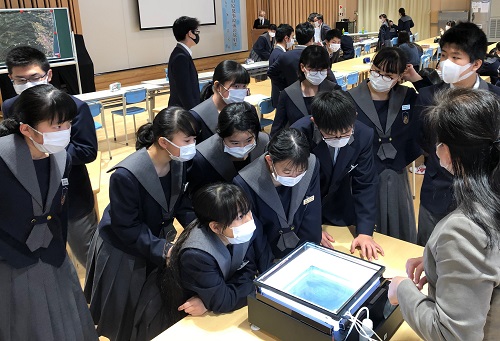 Observing a cloud chamber
Observing a cloud chamber
The total number of students at Naraha Junior High School was about 300 before the earthquake, but now it is 39. Even so, the school is actively working on projects to revitalize the town, and we felt that the brand new and comfortable schoolhouse was full of students’ power and vibrancy.
A science teacher said that she gives classes saying, “You should be the junior high school students who knows radiation best in Japan”. We hope this dialogue meeting will help them deepen their correct knowledge on radiation and make the teacher’s words true.
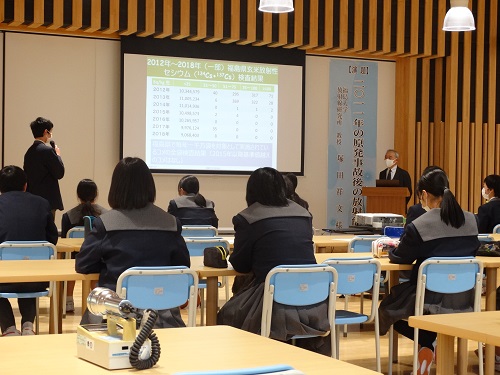 A student expressing his gratitude to
A student expressing his gratitude to
Prof. Tsukada
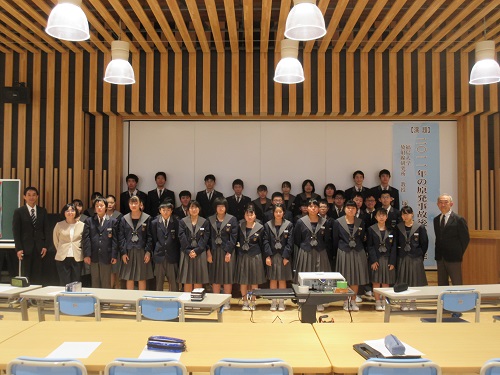 See you again!
See you again!
November 14, 2020 14th Dialogue meeting was held in Fukushima City
| Date : | Saturday, November 14, 2020 16:00-17:30 |
| Venue : | Shimotoriwata meeting hall (Fukushima City) |
| Speaker : | Shota Moritaka 2nd year of master’s program of Environmental Radioactivity major
Kenji Nanba IER Director / Professor
|
| Title : | Estimation of radiocesium wash-off to the river caused by “Shirokaki” (a preparation process of paddy fields before rice planting) in Fukushima Prefecture. |
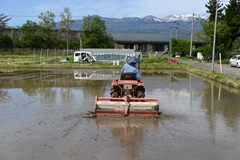 Shirokaki at a paddy field.
Shirokaki at a paddy field.
We held the first dialogue meeting of the year at a local meeting hall in Shimotoriwata, Fukushima City, on the theme of “Estimation of radiocesium wash-off to the river caused by “Shirokaki” in Fukushima Prefecture. Eleven local farmers who helped with this research attended the meeting.
Mr. Shota Moritaka studies the dynamics of radiocaesium in Abukuma River in master’s program of environmental radioactivity major. He has observed and analyzed river water of Abukuma River since 2017 in Prof. Nanba’s laboratory, and has continued his research under Prof. Wada at IER for his master’s study. For the dissertation research, he focuses on seasonal fluctuations in dissolved Cs-137 concentrations in the river water, especially its increase in May. He assumed that one of the reasons of the increase in May is related to “Shirokaki”: an activity to prepare paddy fields by pouring water and plowing the soil.
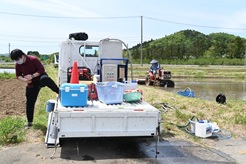 Investigation at the paddy field while the farmer doing Shirokaki.
Investigation at the paddy field while the farmer doing Shirokaki.
With the cooperation of rice farmers, Mr. Moritaka collected water samples from the paddy fields and related waterways and measured the concentration of Cs-137 before and after the Shirokaki activity, then compared it with the results of the water samples from the mainstream, Abukuma River. The results were reported in this dialogue meeting as a feedback to the farmers.
Starting the presentation with the overview of dynamics of Cs-137 in the Abukuma River catchment, Moritaka explained the sampling points, analysis methods, and the results in details with pictures and figures. In this study, he collected and analyzed 1000 to 4000 liter of river water samples.
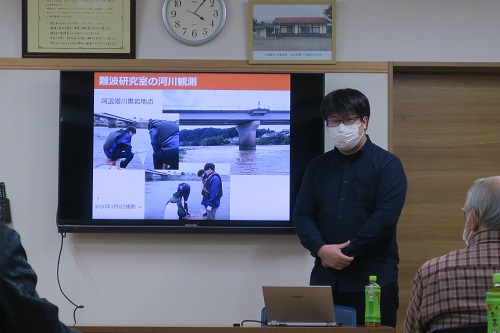 Mr. Moritaka sharing his research results.
Mr. Moritaka sharing his research results.
The results indicated that Cs-137 concentration in river water increases at the period of Shirokaki activity, which suggests the possibility that a certain amount of Cs-137 in paddy soil may be washed off into the river.
There are still some issues that need to be investigated, such as quantification of muddy water wash off, yet these results are expected to contribute for elucidating the migration route and mechanism of radiocesium in the Abukuma River catchment.
Prof. Kenji Nanba, Director of IER, joined in the question and answer session, and the participants gave questions and opinions about sampling methods as well as the measures to suppress the absorption of radiocesium in rice*.
We appreciate the valuable opinions given in this meeting, and with the understanding and cooperation of the local people, we will continue our research activities and create opportunities to continuously feedback our research results.
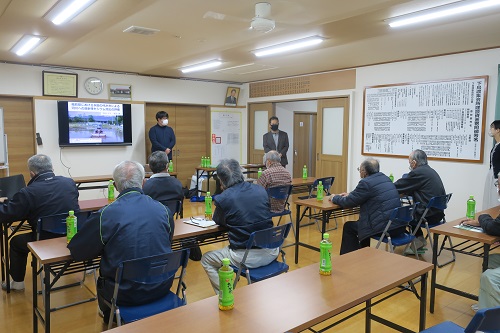 Dialogue meeting at Shimotoriwata, Fukushima.
Dialogue meeting at Shimotoriwata, Fukushima.
(*) In Fukushima Prefecture, zeolite and potassium are applied to paddy fields before planting rice as a measure to prevent the absorption of cesium into rice. Since 2015, the number of cases exceeding the radiocesium standard limit has been 0 in all bag inspection of rice produced in the prefecture. The safety of rice produced in Fukushima is highly evaluated.
January 31, 2020 13th Dialogue meeting was held in Nihonmatsu City
●Date:January 31, 2020
●Place:Nihonmatsu City
IER has continued to hold the dialogue meeting since 2016, in order to feedback our research results to local communities. At the 13th meeting was held on the theme of “福島の林業復活に向けて(Towards revitalization of forestry in Fukushima)” with two presenters. One is the Project Professor Vasyl Yoschenko, who studies on the radiation effect to forest in the exclusion zone, and the other is Seiji Ozawa, the director of Tohoku area office, Ministry of the Environment. Seventy six participants from forestry and local communities, many of those have some connection to the forest in Fukushima.
Professor Yoschenko explained that the radiocesium concentration levels in forests have been decreasing very slowly because radiocesium circulates in the ecosystem cycle of forests, such as foliage falling and returning to the ground as litter followed by roots uptake from soil to the aboveground biomass. He also mentioned that in Ukraine, which was affected by the Chernobyl nuclear accident, the standard values of radionuclide concentrations in wood have been set according to the usage for trying to promote the use of wooden materials safety. Director Ozawa emphasized that the forest that covers a large area in Fukushima Prefecture plays an important role in Fukushima. He also introduced the efforts prefecture has been made for revitalization such as the framework of the "Fukushima Forest Restoration Project" and the study tour that raises awareness of forestry.
The audience asked many questions about forestry and decontamination. We hope that this meeting will serve as a forum for people involved in the forests of Fukushima to exchange and share views and information. And we keep improving our activity with your feedbacks.
.JPG)
.JPG)
(Left) Project Professor Yoschenko is on his presentation.
(Right) Project Professor Yoschenko (left) and Professor Nanba.
.JPG)
.JPG)
(Left) Director Ozawa making a presentation.
(Right)Q&A session. Professor Nanba answering questions as a facilitator.
January 24, 2020 12th Dialogue meeting was held in Kyoto
●Date:January 24, 2020
●Place:Kyoto University, Kyoto
IER has continued to hold the dialogue since 2016, in order to feedback our research results to local communities. With the support of Field Science Education and Research Center, Kyoto University, and Graduate School of Informatics, Kyoto University, more than 120 people from local governments and communities attended the dialogue this time.
With a title of "福島の森・里・川・海の今 ~放射能問題からウナギ・カレイの新発見まで~(Current Forests, Villages, Rivers and the Sea in Fukushima: From Radiation Problems to the New Discovery of Eel and Flounder)", the dialogue was programmed with two themes related to the environment of Fukushima. One theme for the first half of the program was "Fukushima affected by radioactive contamination", in which 4 researchers made presentations on the effects of radiation in agriculture, forest, and seawater, including current situation after many years from the accident.
The other theme was "Fish ecology in Fukushima" on which 5 researchers made presentations. In recent years, various problems have been occurring in the ecosystem of fish in Fukushima, such as invasive species "channel catfish", whose populations are increasing and likely to threaten the native creatures of the Abukuma River, as well as the "Japanese eel" in Matsukawa-ura (lagoon), where its population has declined remarkably. Fukushima University and Kyoto University have conducted surveys on these habitats and ecosystems with the aim of conserving the existing ecosystems. In this dialogue, the researchers talked about fish ecology and research methods that have been revealed in the joint research. The active discussion took place not only about maintaining the environment, but also about maintaining the fishing industry that has used the environment.
We IER held this dialogue in the Kansai region for the first time, and many people were interested in environmental issues in Fukushima viewed from different perspectives. We will continue our activities as opportunities to present our research results to provide and share the information about Fukushima with many people.
.JPG)
.JPG)
(Left) Associate Professor Wada explaining the outline of this dialogue meeting.
(Right)Director Tsukada answering questions.
.JPG)
.JPG)
(Left)Presenters exchanging opinions with attendees. From left, Director Hirofumi Tsukada, Professor Nobuhito Oote(Kyoto University),
Project Assistant Professor Hiroko Ishiniwa, Project Professor Hyoe Tkata,
Professor Nobuaki Arai(Kyoto University).
(Right)From left, Associate Professor Hiromichi Mitamura(Kyoto University),
Professor Yoh Yamashita(Kyoto University), Researcher Takuji Noda(Kyoto University).
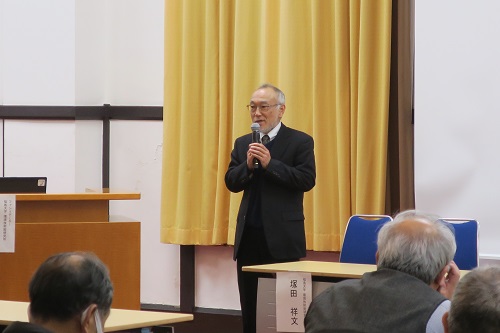
.JPG)
(Left)Professor Yamashita giving a closing remarks. (Right)We had more than 100 atendees.
July 30, 2019 11th Dialogue meeting was held in Namie Town.
●Date:July 30, 2019
●Place:Namie Town, Fukushima
IER has continued to hold this dialogue since 2016, in order to feedback our research results to local communities. This time was its 11th time held in a discussion meeting style between IER Director Tsukada and 17 farmers from Namie Town, mainly Tateno area.
With the title of "農業環境における放射性セシウム等について(About Radionuclides on Agriculture)", the meeting started with a basic explanation of radiation, followed by somewhat specialized contents related to agriculture. For example, Director Tsukada mentioned that the soil quality determines the amount of radionuclides (mainly indicated cesium in the meeting) transferred from soil to plants.
Since 2014, the whole Namie Town has continued an approach to farming resumption based on the revival plan developed by Namie Town Agriculture Reproduction Councilor. In the future, it is planned to resume the livestock industry that had flourished in this area before the earthquake. With this plan in mind, many opinions were exchanged among participants, such as questions about radiation that farmers felt through their farm work, and requests for research that would ensure the safety of agricultural products from the area.
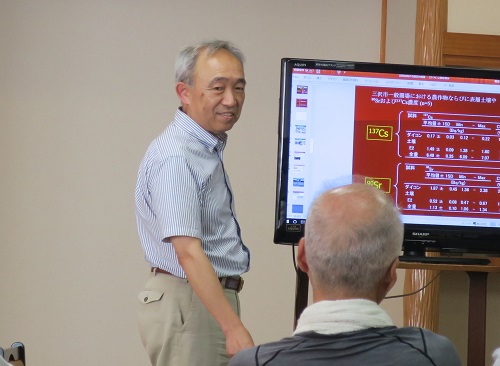
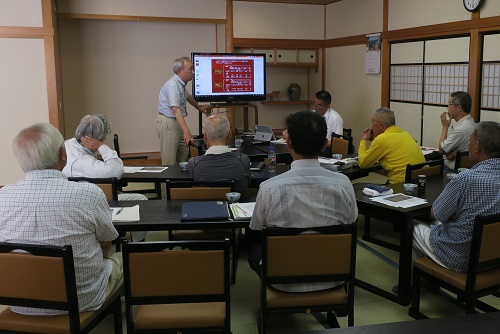
(Left)Director Tsukada giving a presentation.
(Right)Lively discussion with participants.
March 2, 2019 10th Dialogue meeting was held in Koriyama
●Date:March 2, 2019 13:30~16:00
●place:Koriyama city, Fukushima
IER has continued to hold this dialogue since 2016, in order to feedback our research results to local communities.
More than 60 people from local governments and communities attended the dialogue meeting, which was supported by the Kuramae-Kogyo-kai Fukushima branch (supporter’s association of Tokyo Institute of Technology.).
In Fukushima, river fish such as ayu (sweet fish), wakasagi (pond smelt), and koi (carp) are popular, and many people enjoy fishing in rivers and ponds. Given that our daily life is deeply connected with river, we set the title “福島県の放射能の今~淡水魚から考えよう(Let’s think about radioactive contamination on “Freshwater Fish” in Fukushima)”
and five presentations were made by experts from Tokyo Institute of Technology, Fukushima Prefecture, Koriyama City, Abukuma River Fisheries Cooperative Association, and IER. The audience asked many questions and had active communications with the presenters.
We received comments from the participants saying that the meeting program was interesting with the various topics from industrial perspective to scientific study, the scientific term should be explained plainer to public, and etc. We will take your comments to improve our dialogue meeting.
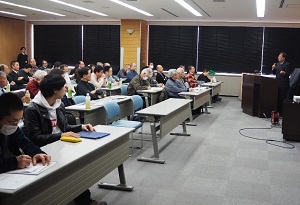
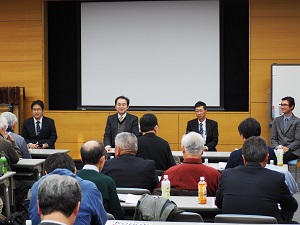
(left)Presentaion by Kiyoshi Horie (Abukuma River Fisheries Cooperative Association).
(right)Presenters exchanging opinions with participants. From left, Toshihiro Wada, Akira Kato (Institute of Tokyo), Tsuneo Fujita (Fukushima Prefecture), Katsunori Yanai (Koriyama City)
November 16, 2018 9th Dialogue meeting was held in Soma
●Date:November 16, 2018 10:00~12:00
●place:Soma city, Fukushima
On November 16, IER held the 9th dialogue meeting in Soma city.
IER has been holding these meetings since 2016, in order to feedback our research results to local communities as our research cannot be done without understanding and cooperation of local community and we believe it is our responsibility to share the obtained results with the public. The main audience of the meeting were local farmers.
Prof. Nanba made a presentation on the temporal change of radiation in the evacuation zone, and how the nuclear accident has influenced wild animals, particularly wild boar.
The other presenter, Prof. Thomas Johnson, a visiting professor from Colorado State University, talked about the biological influences of long-term low-level radiation on wild animals by comparing between mice living in evacuated area and those in non-evacuated area.
One participant remarked that he was surprised to see the discrepancy between the presented data and what the rumors are saying.

June 29, 2018 8th Dialogue meeting was held in Iwaki City
●Date: Friday, June 29, 2018
●Place: Iwaki City, Fukushima
IER held the 8th dialogue meeting on research activities at Futaba Town Office temporarily operated in Iwaki City. IER Associate Professor Toshihiro Wada reported on the concentration of radioactive cesium in fish and the environment in Futaba Town. After that, IER Professor Nanba also participated in the Q & A session on the concentration of radioactive cesium in the environmental water and fish. IER Project Assistant Professor Hiroko Ishiniwa explained the effects of radiation on large Japanese field mice. We will continue our research in Fukushima Prefecture with the cooperation of residents of Futaba Town.
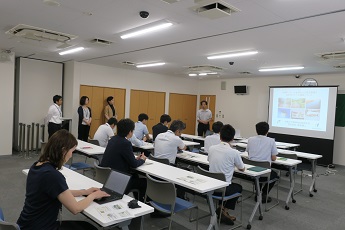
May 29, 2018 7th Dialogue meeting was held in Fukushima City
●Date: Tuesday, May 29, 2018
●Place: Fukushima City
IER held the 7th dialogue meeting at Abukuma River Fisheries Cooperative Association located in Iizaka Town, Fukushima City. Mr. Kiyoshi Horie, Executive Director of the Association, IER Professor Kenji Nanba, IER Associate Professor Toshihiro Wada, and the students of Fukushima University Symbiotic Systems Science and Technology participated in the presentation to report the current status of radioactive materials concentrated in river water and fish in the Abukuma River catchment. The participants exchanged opinions particularly on the fact that specimens exceeding the standard levels, especially of the species inhabiting a mountain stream such as Yamame and Iwana fishes, are still found sporadically in Fukawa, Date City, where they conducted a priority survey.
Before the nuclear accident, more than 4,000 members of the Association were engaged in various activities such as fishery, education and hobbies in the Abukuma River, which remains restricted continually after the accident. We will continue to conduct research activities aimed at resuming activities in the Abukuma River.
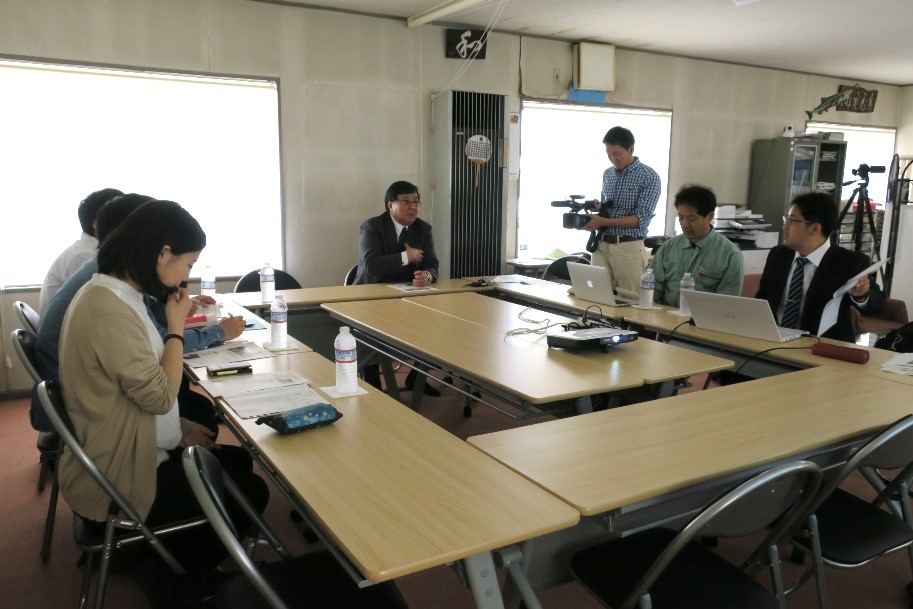
January 24, 2018 6th Dialogue meeting was held in Namie Town
●Place: Wednesday, January 24, 2018
●Place: Namie Town, Fukushima
IER held the 6th dialogue meeting in Namie Town, inviting the local people involved in forestry. There were 31 attendees. IER Project professor Vasyl Yoschenko reported on the current situation of pine trees, cedar trees, and cypress trees, which he has surveyed in Namie Town.
First, Professor Yoschenko used diagrams to explain how the trees were contaminated by radiation. Then he explained the current situation of radioactive contamination of the trees and about possible countermeasures. After the report, some participants made comment: "We would like to continue to exchange ideas with IER researchers, working with them to restore the forestry for the next generation in the future."
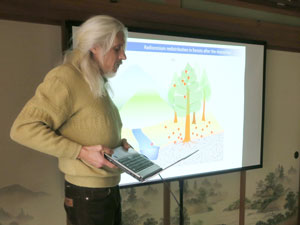
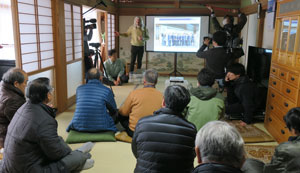
(Left) Prof. Vasyl Yoschenko making presentation.
(right) At the venue of this dialogue meeting.
November 25, 2017 5th Dialogue meeting was held in Tokyo
●Date: Saturday, November 25, 2017, 13:00~16:00(Reception started from 12:30~)
●Place: Miraikan, National Museum of Emerging Science and Innovation 7F, Tokyo
Three IER researchers made a presentation on their research at Miraikan, National Museum of Emerging Science and Innovation in Tokyo. This is the first time that IER dialogue meeting was held outside Fukushima Prefecture. The meeting was held with the theme "福島の避難地域の野生生物のいま(Wildlife Now, in Fukushima Evacuation Area)" in the aim of giving citizens outside Fukushima a better understanding of the current situation in Fukushima. There were 117 attendees.
In the Q&A session, the attendees and the presenters exchanged opinions actively. It was a valuable time for us, as we got to know the people’s expectations for our research activities, other than questions about the contents of the presentation. Some attendees commented that IER dialogue meetings should be continued regularly in Tokyo in the future.
| Title |
Presenters |
環境中における放射性セシウム(Cs)の”ふるまい”と福島の状況
Behavior of Radiocaesium in the Environment and Its Status in Fukushima |
Hirofumi Tsukada |
福島高線量地域に生息する野生生物の状況~消滅か繁栄か?~(逐次通訳)
Wildlife in Fukushima's highly contaminated areas…perished or thriving? |
Thomas Hinton |
原発周辺水域における魚類の放射性セシウム汚染状況
Radiocesium contanimation levels of fish inhabiting water bodies near the FukushimaDai-ochi Nuclear Power Plant |
Toshihiro Wada |






| At the ceonference hall |
Vice Director Hirofumi Tsukada |
| Professor Thomas Hinton |
Associate Professor Toshihiro Wada |
| At the feedback session |
(From Left)Prof.Hirofumi Tsukada, Prof.Thomas Hinton, Prof.Kenji Nanba, Associate Prof.Toshihiro Wada |
July 29, 2017 4th Dialogue meeting was held at Aquamqrine Fukushima in Iwaki
●Date: Saturday, July 29, 2017 10:30~15:00
●Place: 1F Marine Theater, Aquamarine Fukushima, Iwaki City
●Presenters:
Toshihiro Wada(Associate professor, IER)
Michio Aoyama(Project professor, IER)
Takami Morita(Director of radiation analysis group, National Research Institute of Fisheries Science)
Yoshiharu Nemoto(Manager, Fishery Environment Department, Fukushima Prefectural Fisheries Experimental Station)
Takashi Ishimaru(Project professor, Tokyo university of Marine Science and Technology)
Yuya Shigenobu(Researcher of radiation analysis group, National Research Institute of Fisheries Science)
Seiichi Tomihara(Veterinarian, Fukushima Marine Science Museum, Aquamarine Fukushima , Institute of green aquamarine and environment)
IER held the 4th dialogue meeting on research activities at Aquamarine Fukushima in Iwaki City, under the theme of "Radioactive Contamination of Sea Areas: Now and Future — Toward the Reconstruction of Fisheries in Fukushima Prefecture", presented by not only IER, but also Fukushima Prefectural Fisheries Experiment Station, Tokyo University of Marine Science and Technology, National Research Institute of Fisheries Science, and Fukushima Marine Science Museum (Aquamarine Fukushima).
After the presentations, the presenters exchanged opinions with the attendees, and lively discussions were made, including questions about the presentations and comments on future research.




January 27, 2017 3rd Dialogue meeting was held in Minami-Soma City
●Date: Friday, January 27, 2017 13:30~16:30
●Place: Minami-Soma City Hall 2F
●Presenters:
Toshihiro WADA (Associate Professor, IER)
Yoshifumi Wakiyama (Senior Assistant Professor, IER)
Daigo Morishita (Fukushima Prefectural Inland Water Fisheries Experimental Station)
Kazuyoshi Takazaki ( Fukushima Prefectural Inland Water Fisheries Experimental Station)
Seiji Hayashi (Research Director, National Institute for Environmental Studies)

IER held the 3rd dialogue meeting at the City Hall of Minami-Soma City. Under the theme of “新田川・真野川水系の現状 (The current situation of the Niida River and the Mano River water system)”, several researchers from Fukushima Prefectural Fisheries Experimental Station and National Institute for Environmental Studies as well as IER made presentations on the studies conducted at the Niida River, the Mano River and the basin of both rivers.
In the meeting, researchers explained about their research results, saying "As for the concentration of cesium in the rivers, the secular variation of the concentration of cesium 137 in the river water was lower than the predicted value, and the decrease was remarkable in the upstream area where decontamination was advanced. Therefore, it is considered that the decrease in the concentration was accelerated by decontamination." The researchers also reported that the concentration of radioactive cesium in fishes living in both the Niida and Mano Rivers was significantly lower than immediately after the accident, but some fish were still found with exceeding standard level of cesium, and that monitoring should be continued toward future.
After the report, there were lively discussions on the presentations with questions and comments from the participants.
November 21, 2016 2nd Dialogue meeting was held in Iwaki City
●Date: Monday, November 21, 2016 14:00~16:00
●Place: Okuma Town Branch Office in Iwaki City

IER held the 2nd dialogue meeting at Okuma Town Branch Office in Iwaki City. We have studied in the evacuation zones in Fukushima Prefecture, with the understanding and support from the local government and communities. IER has carried out a lot of field studies in Okuma town for a variety of research themes. At this meeting, some researchers made presentations to feedback research results to the people of Okuma Town.
After the presentation, researchers and participants actively changed opinions, with the local people asking about the presentations and the researchers asking about their current situation in the area. We would like to utilize the opinions from the participants in our future research activities.

(From Left)Associate Prof. Toshihiro Wada, Senior Assistant Prof. Yoshifumi Wakiyama, Project Prof.Kei Okuda
August 2, 2016 1st Dialogue meeting was held in Namie Town
●Date: Tuesday, August 2, 2016 13:30~16:30
●Place: Namie Town Office

IER held the 1st dialogue meeting in Namie Town. In the meeting, IER Professor Thomas Hinton and IER Project professor Kei Okuda, who study on radiation effect on mammals mainly in Namie Town, and IER Professor Alexei Konoplev who studies on reservoirs and water system in Fukushima, gave presentations on each of their findings.
Eight of hunters from the town also joined the meeting. We have received a great deal of cooperation from them in our research on wild animals, especially on boars. Many questions were asked from them about the ecology of wild boar, its current situation, the aim and meaning of research, and countermeasures and solutions toward the problems they have faced.
participants also asked how much the research results would impact on the possibility of the residents to return to the town. IER Director answered that, in case a research result has a major impact on policy decisions, IER would be prepared to inform the relevant ministries, agencies and residents. In that sense, IER would like to continue this dialogue meeting with local public on a regularly basis.

Project Prof.Kei Okuda |

Prof.Thomas Hinton |

Prof.Alexei Konoplev |
 Participants gathered from inside
Participants gathered from inside Discussion session
Discussion session
 Posters of the research
Posters of the research Presentation in the dialogue meeting
Presentation in the dialogue meeting
 Field work
Field work
 Field work
Field work




































